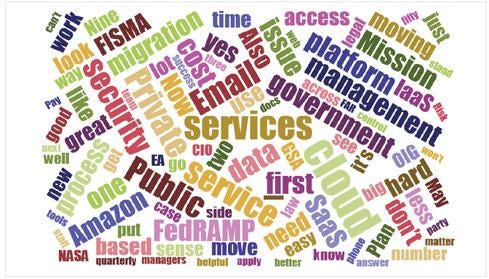Government IT's Next Step: Digital Investment
A tight but effective IT budget creates opportunities for new investments in digital government, say government IT leaders at Gartner Symposium.


5 Early Cloud Adopters In Federal Government
5 Early Cloud Adopters In Federal Government (Click image for larger view and slideshow.)
Run a tight ship in government IT and you will get more opportunities to chart a better course.
Cost optimization done right leads to new opportunities for digital investment, IT leaders from the General Services Administration (GSA), US Air Force, and the City of Omaha, Nebraska, said in a workshop on cost optimization at Gartner Symposium.
"Cost optimization isn't necessarily cost-cutting," said Derek Kruse, CIO for the City of Omaha and Douglas County. Cost cutting and cost controls are powerful tools for establishing credibility, but once you establish credibility, the organizations you serve are likely to give you opportunities to do more exciting and innovative work, he said.
Before his organization could get to that point, it had to become much more transparent about how the technology budget is spent -- including monthly cost accounting briefings for key stakeholders, as well as for the public. "For the first year, it was just torture," he said, but gradually his team was able to establish a pattern in which month after month it was able to demonstrate improvements.
[Making it count: Federal Agencies Struggle To Quantify Data Consolidation Savings.]
Managing costs is important, "but the real benefit is likely to be on the value improvement side," agreed Jerry Mechling, a VP at Gartner Research and a retired lecturer from Harvard's John F. Kennedy School of Public Policy who studies the impact of networked government services. "To get to that point is very important -- a lot of us are not there yet."
Digital government can make government more efficient, but in areas such as digital services to citizens the benefits may show up elsewhere, such as sparing citizens the need to visit a government office to perform a task they can accomplish online. "In that case, what you're saving is the public's time."
Similar stories of starting with cost control before progressing to more exciting things came from David Shive, associate CIO at the GSA, and David Drake, a senior IT technical advisor to the Air Force and also a consultant to the Department of Defense.
Figure 1:  (Source: Wikimedia Commons)
(Source: Wikimedia Commons)
Drake said that when the stock market took a nosedive in 2008, his team was sharp enough to anticipate the budget cuts that would follow and made some strategic investments before the money dried up. "Our response was to virtualize everything we could," he said, while also instituting a strong IT portfolio management program.
As a result, the Air Force was able to cut the IT budget by 50% and it is able to operate better today than before those changes. Because the IT team anticipated what was coming, "the cuts came before we absolutely had to have them. We just make ourselves more efficient and effective, which is what you should always be striving to do," he said.
At about the same time, he began a push to "win back the mission business," meaning the share of IT directly related to achieving the Air Force's mission rather than to more administrative functions.
Mechling prompted Drake to specify to what extent savings were the result of pushing for greater standardization of technology, and Drake agreed that was a big part of it. However, he cautioned you can easily squander whatever savings you might have achieved by pushing standardization where
it does not make sense -- for example, by imposing standard commodity storage suitable for small, frequently accessed records on large, important, but infrequently accessed digital objects. It's important to recognize legitimate distinctions in the business use-case that justify the use of a different technology and not say, "This one solution works for everybody," he said.
Shive said GSA's IT infrastructure is "completely different" from what it was five or six years ago, with a much greater emphasis on consolidation and shared services. Before the consolidation push, different business units "would deliver the same product or capability over and over again," he said. Yet the agency's culture was such that imposing a "draconian top-down" consolidation initiative would not have worked well, even though IT ultimately secured the support of top management.
"Instead, we decided we would try to lead by example," Shive said, consolidating a few services "to show we can do a good job, show we can produce a return." GSA was the first federal agency to consolidate its email services onto Gmail, for example. Those first products built the business case for a broader consolidation initiative that saved $100 million over five years, he said. In addition to consolidating data centers, GSA rationalized its application portfolio, weeding out 16 different budget systems in the process.
Kruse agreed that imposing change is often not the best tactic. "You don't build trust by walking into a shadow IT group and saying, 'Here is how we're going to do things,'" he said. Instead, it's much more productive to establish a culture where IT is always asking "How can I help you?"
"You have to be able to interact not just as the IT guy but to give them counsel, give them technology solutions," Drake said. In the Air Force, the key to winning back involvement in mission-related IT was investing more time in understanding the military mission and what IT could do to support it.
"That's when customers will come to you," Kruse said. "If you do this right every time, you should expect they will begin to come to you with investment ideas."
That's the pivot you want to see: from cutting IT to investing in digital solutions.
Find out how NASA's Jet Propulsion Laboratory addressed governance, risk, and compliance for its critical public cloud services. Get the new Cloud Governance At NASA issue of InformationWeek Government Tech Digest today. (Free registration required.)
About the Author
You May Also Like






